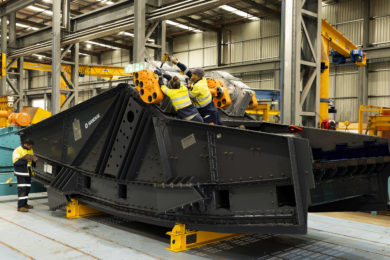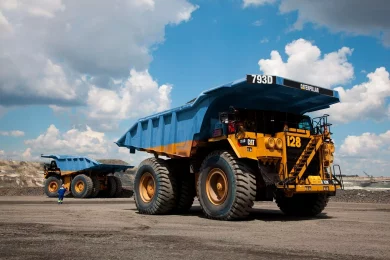International Mining Editorial Director Paul Moore recently had the chance to catch up with Gernot Beutle, eMining Switzerland Sales Project Manager, to get an exclusive insight into progress with its all electric mining truck program. It remains the only company globally to have successfully built and put into commercial operation a fully battery powered surface mining haul truck, which is a converted Komatsu HD605-7 (63 t payload) “eDumper.” The first machine has now been running for some time at the launch customer Ciments Vigier SA at its limestone quarry near Biel-Bienne in Switzerland.
PM: What is the status of the quarry project in Switzerland, how many trucks are now running there and what are the plans going forward?
GB: Up to now, we still have just one 605-7 conversion eDumper machine in operation; currently we are looking at higher payload dump trucks as future targets. However, we are talking to our existing client about adding more trucks, though this will depend on their investment plan. Elsewhere, we are in discussions with many potential customers around the world. As an example, one industrial minerals mining company intends to purchase four units of our 605-7 conversion machines. We have completed the planning and assessment stage and are at the negotiation stage
PM: What refinements to the design have you made to the HD605 based truck based on the project?
GB: The drivetrain has been completely removed and refurbished, and the whole package was replaced by an electric motor/planetary gear drivetrain. Also due to the lack of dump body heating (no exhaust gases) and the fact that this operation includes cold winter conditions we had to use new build rubber suspended dump bodies (SDBs) from Duratray on the truck
PM: Is the current truck now part of normal operations at the mine?
GB: Yes, for a year now and with great success, I must add. Compared with conventional diesel trucks our truck has higher torque, higher speed and better acceleration meaning it can achieve higher efficiencies. So overall operational cost is lower but the initial capital cost is still significantly higher. We are therefore calculating its value based on TCO to the mining customer. Maintenance is less demanding as with the diesel-powered machine due to a more robust design of the electric components and less wear.
PM: What are the main lessons learned from the project so far?
GB: In poor road conditions the energy demand on the truck when using snow chains was higher than expected but was not an issue in normal road conditions, and only a minority of surface mines have to use chains anyway. We also think going forward that the charging station should be in our scope in order to avoid interface problems
PM: What about charging? How is the truck currently charged and how will this change going forward. Also will you stick with the same battery type?
GB: Currently the truck is charged overnight using a fixed plug in charging station located in a dedicated truck park area. This charge is enough for up to three days of operation. Having said that, this is still not suitable for most metallic mining operations that run 24/7, with the exception of some specific mines with a lot of downhills where the battery can recharge that way. So we are working on fast charging of only 10-15 minutes as well as using automated charging stations. But this will require use of different battery chemistry; currently the truck uses NMC lithium ion batteries but we will need to switch to LTO lithium ion. This will likely be done on the 63 t truck first but the mentioned new sales that are in discussion still relate to trucks with NMC batteries. The other issue with NMC is the lifespan as they need changing every three to four years. But overall batteries are getting lighter, cheaper and smaller which helps us. And the drive to zero carbon emissions continues so there is a lot of scope in this market
PM: To what extent are you working directly with Komatsu or other OEMs on the technology going forward and potential for the 100 t truck?
GB: Our business is to convert machines of all brands if it is environmentally thorough and economically feasible. I can say that all the major mining truck OEMs have signalled high interest in our product and some have also been to the quarry to see the truck. But the biggest potential worldwide are 110 ton (100 t) trucks which will be our major focus development for the coming years
PM: To what extent have you received interest around the world in eMining and do you have plans to market the truck technology globally? Would this be independent from your major shareholder KUHN Schweiz?
GB: We have projects in Europe and overseas with well-known companies in this industry looking at feasibility studies and engineering studies etc. Apart from the mentioned OEM discussions this is mainly with the mining companies themselves who have obviously shown great interest and some of these mining houses have also visited the truck. One business model will also include a possibility to deliver component kits and services with the opportunity of our clients or sales partners to assemble the vehicles on their own. KUHN Switzerland will always be our main stakeholder but the fact that we will offer this technology to everybody will make us independent to a certain degree
PM: What are the next steps for eMining for 2019 and 2020 in terms of plans and major milestones coming up?
GB: As our main priority, we will market the eDumper 605-7 conversions in order to have our operation running smoothly. As an evolution, as stated there will be an eDumper 605 version with a fast charging battery chemistry and an automatic charging station for operations with more than 2,500 hours per year of operation. The 110 ton eDumper vehicle will be our other major development focus for the next few years










